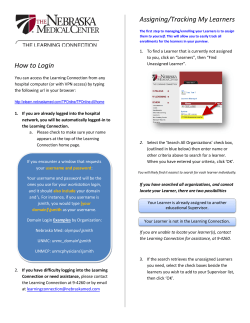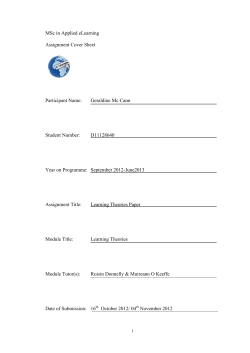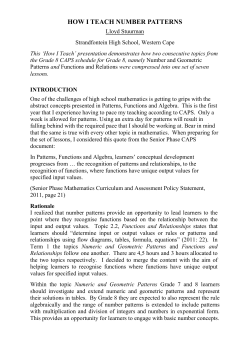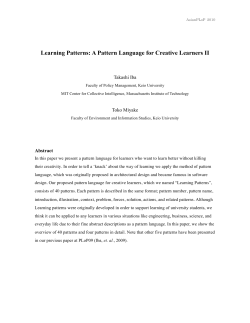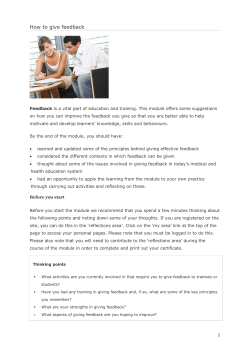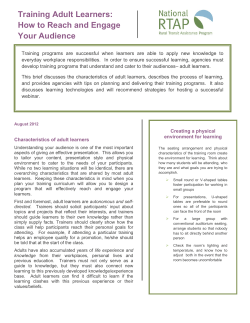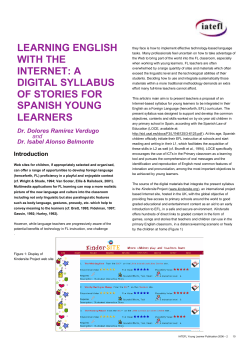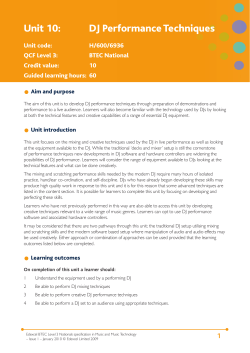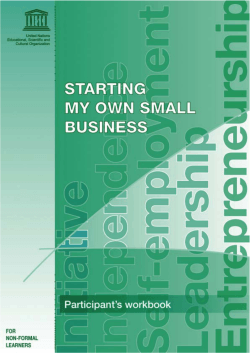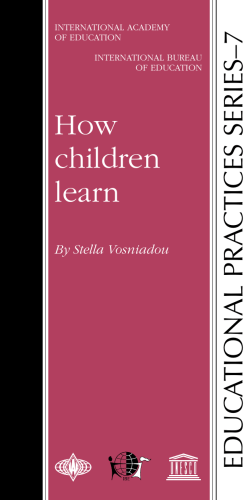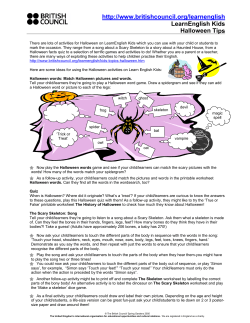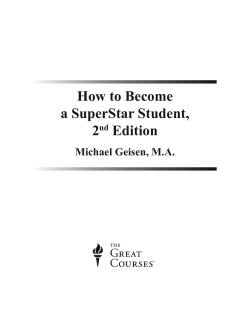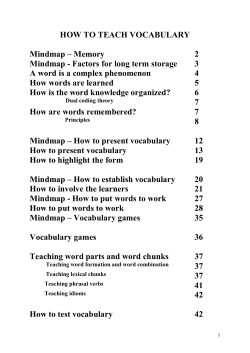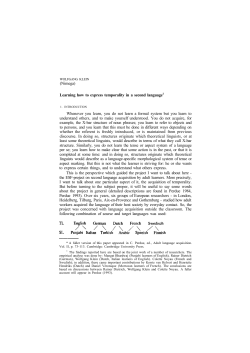
How to Give a Better Meeting Presentation
How to Give a Better Meeting Presentation TABLE OF CONTENTS FIRST STEPS: ABSTRACT, PREPARATION, AND PRESENTATION ....................................1 Charles G. Haws, Society of Biblical Literature GIVING A BETTER PRESENTATION AT THE MEETING ......................................................3 Laura Nasrallah, Harvard University GIVING A BETTER MEETING PRESENTATION......................................................................4 Heather McKay, Edge Hill University Matthew S. Collins FRAMEWORK FOR HIGHER EDUCATION QUALIFICATIONS ............................................6 Heather McKay, Edge Hill University GRAMMAR AND VOCABULARY FOR PRESENTATIONS ....................................................7 Heather McKay, Edge Hill University HOW TO GIVE AN ACADEMIC TALK ....................................................................................13 Paul N. Edwards, University of Michigan LEARNING STYLES AND MULTIPLE INTELLIGENCE .......................................................19 Heather McKay, Edge Hill University HINDRANCES TO LEARNING AND HOW TO AVOID THEM .............................................22 Heather McKay, Edge Hill University WORD WISDOM: SAYING IT ALL WITHOUT SAYING TOO MUCH .................................27 Heather McKay, Edge Hill University LEARNING STYLES QUESTIONNAIRE ..................................................................................28 Peter Honey and Alan Mumford First Steps: Abstract, Preparation, and Presentation by Charles G. Haws Abstracts Before one is able to give a presentation at the Annual Meeting, one must of course submit and have accepted an abstract. What can be said for first impressions in the interpersonal sphere can also be said for abstracts. Your abstract provides a program unit chair with his or her first impression of you, so you need to put your best foot forward. So what must you do to have an abstract accepted? 1. Inform yourself • Read the call for papers carefully. Some program units will only have one open session or might want papers only on a particular method or approach to their larger area, so you should focus your research accordingly. • Communicate with the program unit chair via email if you have questions or concerns, or if you want to do something a bit different than what the call for papers requests. Chair emails are listed in the call for papers on the SBL website. 2. Write a quality abstract The best abstracts, which lead to acceptance of the proposal, have the following characteristics: • Succinct, which means “precise expression in few words.” Abstracts should be concise but not abbreviated. • Clean. An abstract riddled with mistakes will greatly reduce the chances of even the most original thought being accepted. • Technical. Though brief and summative, abstracts should nonetheless maintain the analytical technicality of the paper or presentation itself. The standard for academic work remains in place for presentations: demonstrate that you know the relevant literature or theory, make an original point or original reformulation, and show the relevance of your work by situating it within the broader framework of your field. • Articulate. Ho-hum diction dims the glass through which the light of your presentation might otherwise shine. This hardly means that you should pontificate; rather, it means that you should eliminate the “fluff” or “chaff” in your abstract and get at the “heart” of the matter. • Engaging. Perhaps most important is that your abstract harnesses your reader’s attention. Gimmicks might work in the marketing world; clever style and original thought are keys in the academic world. If you have satisfied these criteria and do, in fact, have an abstract that responds to a call for papers properly yet creatively, then your chances for success will greatly increase. Preparation After your abstract has been accepted, you should use the time until the meeting to prepare yourself and your presentation. The major realization in this process is that a presentation is not a paper; it is not a written document submitted to a reader. A presentation must be crafted for listeners, many of whom may not be speakers of your native language. How might you develop such a presentation? 1 of 31 1. Hone Content • You are not sharing a book or even a journal article; a presentation should be catered to oral delivery and aural reception. • Be witty – an appropriate humorous comment where appropriate can ease the tension and keep your audience engaged. 2. Practice • Perhaps it sounds silly, but read your paper aloud several times with a clock or watch to see how long it takes, revise it as necessary to fit it into the time you are allotted. Do not put the presider of your session in the awkward position of having to glare at you, clear her throat to get your attention, or just interrupt you because you have wandered into another presenter’s time. • Practice again, so you can be as relaxed and natural as possible in your delivery. • Practice again with your colleagues, a significant other – or even a pet! • Practice again….and again…. 3. Anticipate Questions • Be prepared for the “obvious” questions. • Ask yourself questions about your presentation. For example, Can you explain that further? What do you mean by that? Can you give an example of that? Do you have evidence for saying that? What would be the consequences of that? Is there another point of view that merits a mention? What might someone who disagreed with you say in response? What are the differences between those views? Is it possible to make up a conclusion from what you've said? Presentation Again, a presentation must be crafted for listeners, many of whom may not be speakers of your native language. This consideration must inform the speed and volume of your delivery, the intentionality of your body language and eye contact, and even the diction you use. What should you do to present well? 1. Use Simple Language • When giving an oral paper you should ensure that the main idea of the sentence comes first so that the listeners do not have to hold the first non-specific clause in their heads without knowing the topic/reason for the statement. 2. Focus on Delivery • Pauses and repetitions are clues to important indicators. Use them wisely. • Your delivery should be at about 120 words/minute (BBC News on the Radio World Service is 100 wpm). This speed is important if you are not sure of either the audience's ability in English or their familiarity with the topic. A typical 20-minute presentation translates, then, to no more than 2400 words. 3. Put Yourself in the Audience’s Shoes • For how long are you willing to listen to a speaker? • Do you prefer to be read to in a dreary monotone or to in a lively and inflected tone matched by consistent and frequent eye contact? • Even if the room is not large and you have a booming voice, ask your listeners to wave a hand or your handout at you if they cannot hear. Both the speaker’s question and the listener’s action are simple gestures that facilitate successful presentations. 2 of 31 Workshop: Giving a Better Presentation at the Meeting (S20-139 11/20/2006) Suggestions from L. Nasrallah ▪ Harvard University Divinity School I. Before you submit the abstract, consider: When/why should I present a paper? For feedback? Help? Performance? Exposure? In what section should I present a paper? Where might you best fulfill your goals above? Do not submit an abstract in a topic that interests you but which you have not yet begun to research or to write. II. Preparing and Delivering Oral Presentations: Your Responsibilities Before and as you write, make this a truly pedagogical enterprise. Consider your content: What do you want to teach? Why? Consider your audience: To whom do I hope to speak? What do I wish to evoke in my hearers? Consider yourself: Who am I as a teacher and communicator? Consider, above all: So what? Why should the audience care about your paper? As you write, strive for clarity. Prepare a fully written, short presentation with a clear thesis and a few main points to be developed. Avoid jargon. Leaven with humor if possible. As you write and especially as you present, have mercy. Remember the material conditions of your audience: exhausted, uncomfortable, hungry, perhaps with English as their second language. Imagine your audience as intelligent people untrained in the particulars of your research topic. Offer oral markers, such as an introductory “road map” of where you are going, and frequent enumerations and markers of shifts in your argument. (See SBL McKay/Collins handouts.) III. Preparing Oral Presentations: Institutional Help If you are a student, ask for your department to run practice sessions. Organize with friends/colleagues: do not present, especially for the first time, without having someone read or listen to your talk first. Use SBL aids offered online (authored by Heather McKay, Matthew Collins, and others). IV. Miscellanea Aids to oral presentation: handouts and powerpoint. Use judiciously. Do not expect people to read a passage as you are presenting, unless you read it to them yourself. Do not overwhelm with slides and images: include only those you talk through carefully. Replying to questions/enjoying the discussion period. In general, questions should not be taken as hostile or challenging. Even if they are, respond as if they are helpful! You are the expert on your paper; you are also presenting in order to learn more and to sharpen your ideas. 3 of 31 Giving a Better Meeting Presentation Matthew Collins, Society of Biblical Literature, Presiding Heather McKay, Edge Hill University, Presiding GENERAL POINTERS RE ORAL PAPERS 1) When giving an oral paper you should ensure that the main idea of the sentence comes first so that the listeners do not have to hold the first nonspecific clause in their heads without knowing the topic/reason for the statement. (See Examples on Sentences sheet) Work through Sentences Handout 2) Your delivery should be at about 120 words/minute (BBC News on the Radio World Service is 100 wpm). This speed is important if you are not sure of EITHER the audience's ability in English OR their familiarity with the topic. This means that if you truly want: • your audience to hear and take in what you say • to give your audience time for questions and discussion you must limit your paper to about 2400 words AND NO MORE. Otherwise the audience will draw the conclusion that you do not care for their input. 3) Also you should support the listener with a Handout‡/OHTs/PowerPoint presentation*. You would put unfamiliar Names and/or their Bibliography entries on an OHT or Handout, in the order you will reach them (rather than alphabetical). You would put these in NUMBERED ordered sections of your argument so that they accompany your delivery. I know this to be beneficial from feedback from a European friend who particularly likes a numbered handout corresponding to my subheadings/topics so that if she gets 'lost' she can catch up again; many non- native speakers recognise numbers more readily than letters for listing points. Also, you should open each new section, or every couple of paragraphs with a phrase such as: • Taking that argument even further . . • Building on my fourth point . . . • Looking at criticisms of this position we find that . . Please remember the times you have ‘lost the place’ in a lecture in the warmth of a drowsy afternoon and provide these helpful ‘signposts’ to your listeners. They will appreciate them, even if not fully realising what you have done . . . *For each of these, check on the Print Preview screen that you can read clearly what you have written; then it will be large enough AND uncrowded enough on screen for your audience to take in. ‡ Ask someone RELIABLE to give out handouts and to thrust them in the faces of latecomers (who will otherwise never notice them!) 4 of 31 NOW SOME PARTICULAR POINTS 1) Developing a sense of how the reader/listener reads/hears your ideas and conclusions. This is largely answered above, but mainly depends on your power to engage the audience with your gaze, i.e. you must keep looking up and towards them (not stare fixedly at your notes). Then, you will be able to notice mystification of their faces and restlessness in their body language if they cannot follow you (or your handout) or if you are too quiet. Just ask them to wave the handout at you if they cannot hear!. Experience of this comes from teaching classes and shows by your putting in verbal links like: • Moving now to my third point • Considering the opposing argument we find that ... and so on. 2) Knowing how much the speaker can assume from the audience. Presenters in the Germanic tradition usually spend about 3/4 or MORE of their papers on what many senior scholars have said on their topic and only a TINY fraction of their time on what THEY have researched and concluded. This is their way of solving this query, but it's not very interesting to the listener. I believe that you should briefly outline the work you are developing from or in contestation with (using the Harvard system of names and bibliographic detail), but, to my mind (and take others' opinions on this too), this should not be more than HALF of what you deliver and could be less, say a quarter to a third, especially if what you have to say is a) interesting, and b) answers the 'So what?' question, i.e. Why should the audience want to spend 22 minutes of their day listening to the paper? What new insight does it give? or What new question does it pose? (and so on –you should be sure that you have at least addresses, if not answered, one of such questions). AS YOU READ OVER YOUR FINAL DRAFT, ASK YOURSELF THE FOLLOWING ‘DIFFICULT’ SOCRATIC QUESTIONS: Can you explain that further? What do you mean by that? Can you give an example of that? Do you have evidence for saying that? What would be the consequences of that? Is there another point of view that merits a mention? What might someone who disagreed with you say in response? What are the differences between those views? Is it possible to make up a conclusion from what you've said? THEN THINK WHETHER YOU NEED TO USE SOME OF YOUR PRECIOUS WORD ALLOWANCE TO ADDRESS THEM TOO! 5 of 31 6 of 31 * the exercise of initiative and personal responsibility; * decision-making in complex and unpredictable situations; and * the independent learning ability required for continuing professional development. d the qualities and transferable skills necessary for employment requiring: and will have: c continue to advance their knowledge and understanding, and to develop new skills to a high level; b demonstrate self-direction and originality in tackling and solving problems, and act autonomously in planning and implementing tasks at a professional or equivalent level; a deal with complex issues both systematically and creatively, make sound judgements in the absence of complete data, and communicate their conclusions clearly to specialist and non-specialist audiences; Typically, holders of the qualification will be able to: * to evaluate methodologies and develop critiques of them and, where appropriate, to propose new hypotheses. * to evaluate critically current research and advanced scholarship in the discipline; and iv conceptual understanding that enables the student: iii originality in the application of knowledge, together with a practical understanding of how established techniques of research and enquiry are used to create and interpret knowledge in the discipline; ii a comprehensive understanding of techniques applicable to their own research or advanced scholarship; i a systematic understanding of knowledge, and a critical awareness of current problems and/or new insights, much of which is at, or informed by, the forefront of their academic discipline, field of study, or area of professional practice; Masters degrees are awarded to students who have demonstrated: Descriptor for a qualification at Masters (M) level: Masters degree The framework for higher education qualifications in England, Wales and Northern Ireland (QAA 2001) Masters Level Work Other transferable skills descriptors: 8. The learner has technical mastery of a skill, performing smoothly and efficiently. Able to plan strategies and tactics and adapt effectively to unusual and unexpected situations 9. The learner engages with a critical community; reflecting habitually on own or others’ practice in order to improve own/ others’ action 10. The learner is autonomous in study/ use of resources; makes professional use of others in support of self-directed learning 11. The learner can isolate, assess and resolve problems of all degrees of predictability in an autonomous manner 12. The learner can engage in full professional and academic communication with others in their field 13. The learner can work with and within a group towards defined outcomes and can take a role as recognised leader or consultant. Has ability to negotiate and handle conflict. Can effectively motivate others. Cognitive descriptors: 4. The learner has great depth of knowledge in a complex and specialised area and/or across specialised or applied areas. S/he may be working at the current limits of theoretical and/or research understanding 5. The learner can deal with complexity, lacunae and/or contradictions in the knowledge base and make confident selection of tools for the job 6. The learner can autonomously synthesise information/ ideas and create responses to problems that expand or redefine existing knowledge and/or develop new approaches in new situations 7. The learner can independently evaluate/ argue alternative approaches and accurately assess/ report on own/ others work with justification. Operational contexts: 1. Complex, unpredictable and normally specialised contexts demanding innovative work which may involve exploring the current limits of knowledge 2. Autonomy within bounds of professional practice. High levels of responsibility for self, possibly others 3. Awareness of ethical dilemmas likely to arise in research and professional practice. An ability to formulate solutions in dialogue with peers, clients and others. Summary descriptor: Learning accredited at this level will display mastery of a complex and specialised area of knowledge and skills, employing advanced skills to conduct research, or advanced technical or professional activity, accepting accountability for related decision making including use of supervision. Edge Hill University 7 of 31 Means 100%, the = absolute identity or equivalence, so it is ‘safer’ to use: some, many, most, almost all, of the ‘whatever’ it is you are writing about. Always say what the ‘it’ is by using: a noun (this practice/ process/ approach), noun phrase (doing this thoroughly), noun clause (whichever of those two outcomes actually occurs). Means 100%; is = absolute identity or equivalence, so it is ‘safer’ to use: seems to be, seems to me to imply, apparently presents, in my opinion gives, etc. Highly ambiguous because can mean: while, whenever, because, for, since, in order to, in order to avoid, therefore it is ‘safer’ to choose one of those wherever possible Also ambiguous, because can mean: fair, legal, merely, solely, only and since some of these imply a criticism, while others merely describe without criticising, you should choose what you actually wish to say. This what?, your reader asks in despair. This process/ practice/ experience/ event/ way of doing things/ approach/ methodology/ attitude of mind/ personal viewpoint/ etc. Has so many meanings that it is unfair to leave your reader to guess your intention; choose instead which of the following more faithfully represents what you mean to say: must, is required to, would benefit from, is requested to, is intended to, ought to, should, will suffer without. Try to reserve ‘feel’ for matters of genuine ‘feeling/s’; thus, matters of belief, judgement or opinion should be prefaced by phrases such as: in my opinion, I have come to the conclusion that, any careful reader would realise that, any reflective practitioner would decide to, a dedicated practitioner would always take care that, and so on THE FEEL NEEDS TO THIS JUST AS IS IT REASON TO AVOID WORD AVOID THESE WORDS WHENEVER YOU CAN It was evident Crawford (2003) had not explained his key point clearly so while McKay thought she was applying it appropriately, she was not It was evident THAT Crawford (2003) had not explained his key point clearly so while McKay thought THAT she was applying it appropriately, she was not If a researcher claimed the students were keen to tell him/her it was far too difficult a task, I would refer him/her back to them find out what part it was they found difficult. If a researcher claimed THAT the students were keen to tell him/her THAT it was far too difficult a task, I would refer him/her back to them find out what part it was THAT they found difficult McKay (2005) said THAT the idea was feasible. McKay (2005) said the idea was feasible. i.e. re-write them so that the ideas come to the listeners’ ears in the order they need to receive them for optimal understanding. 1) I would like you all to evaluate my key point, by considering its relevance to your daily lives, in particular how the speed at which you complete your work has been affected by the introduction of the new Health & Safety procedures. 2) In their work, the two Korean scholars were particularly prolific and through their use of an amazing range of innovative methodologies, caused the team to re-evaluate completely their own methods of categorising and storing blood test results. RE-ARRANGE THE SENTENCES BELOW TO MAKE THEM MORE SUITABLE FOR ORAL AND WRITTEN DELIVERY. AT PRESENT THE LISTENER HAS TO WAIT TO THE VERY END TO HEAR WHAT THE SPEAKER IS TALKING ABOUT! 3x that 2x that 1x that ALWAYS INSERT ‘THAT’ WHERE IT AIDS THE CLARITY OF YOUR MEANING IN WRITTEN ENGLISH (NOT SO ESSENTIAL IN SPOKEN ENGLISH) SENTENCES AND WORDS IT PAYS TO INCREASE YOUR VOCABULARY NOUNS acceptability acceptance of access activities admission advance aftermath airing of allegiance allocation allotted roles alternative ambition analysis antithesis anxiety approval arrangements aspects aspirations assumption attention attraction attributes authority barrier beliefs capacity characters circumstance clues cluster cohesion collection comments commitment community complementarity concealment conceptions concepts condition constraint construct contemplation continuity contrast control conviction correspondence creation criterion criteria (pl.) custom damage data declaration decoration deficiency definition delegation delight dependence derision detail determination devotee dialogue differentiation discretion display disposition disruption distance distinction distress distribution division donor emotion emphasis enquiry equality evaluation events evidence examples excellence experience explanation extension extent extreme facilitation failure favour field focus force form fulfilment function gathering giver group guarantee harmony idea identity ideology image importance 8 of 31 independence indication indicator individual inferiority influence information initiator innocence instinct instruction intention interaction intercourse interface interpenetration interpretation intervention intimacy introduction investigation irritation judgment kinds knack lack link list literature magnificence maintenance maltreatment management manipulation marketplace mask material meaning means mechanisms mediation members messages mirror mixed messages mode mood multiplicity name narrative nature negation negotiation neutrality norms objective objects obligations occasions occurrences offers opinion opportunities opposition outsider overtones ownership participants participation parties perception performance personnel perspective persuasion phenomenon phenomena (pl.) pledge plethora portrait pose positions possibilities potency potentially power precursor of prelude presentation of preservation presupposition privacy privilege procedure process proclamation product production progress prohibition prominence promotion properties proposition provision proximity public punishment pursuit qualities questions range rank re-interpretation reaction reality realm receipt recipient recognition recommendation record recreation redefinition reduction reflected glory reflection refusal regard rehearsals relationships release relegation relief remainder remedy removal repetition replacement representation repression requirement resistance respect response responsibility responsible restraint revelation revision rhetoric ritual role sanction scrutiny section security self-doubt self-interest sentiments side effect significance silence similarity site of situation solemnity solidarity spectators spheres stability standards standing statements status status quo stimulus strategy 9 of 31 stringency studies successors suggestion summary supply support symbol symbolism tasks test threat tokens tone topic tradition transfer transformation transmission treatment trust type understanding unease values vehicle vitality vulnerability warning wealth well-being willingness wisdom VERBS accentuate accept access accompany acquire adapt to adopt advance affect (alter) affirm alert allowing alter alternate apply arise arrange attracts attributes authenticate authorize believe carry out cause celebrate censure collect communicating comprise conceal conceive condemn confers confine conform contrast contrive control convey convince correspond create deceive declare define delegate deny depend on depict determine disclose discuss disguise divide effected (did) effects (does) emphasize empower enable endorse enhance enrich ensue ensure evaluate examine exchange exclude execute expect explain expose express explicitly extensively extremely facilitate favour feel (AVOID IF POSSIBLE, USE BELIEVE) flaunt focuses follow forbid force form fulfil gather guarantee handle harmonize identify immerse imply (what writer does) infer (what reader does) indicates inform influence inspire interact interface interpose interpret intervene investigate lack link list maintain manage mask means mediate mirror modulate multiplies name narrates negate negotiate objects offers opine opposes outline overwhelm own perceive perform permit persuade pervade pledge points out portray pose preserve presuppose prevail privilege process proclaim progress prohibits promote propose provide publish pursue qualify question range rank re-interpret react recommend record redefine reduce reflect refuse regard register reinforce relate 10 of 31 release relegate relieve remain remedy remove render repeat replace represent repress require resist respect respond restrain sanction secure soften standardize strengthen suggest summarize supply support sustain test threaten transfer transform transmit treats undergo underlie underscore validate widen ADJECTIVES (EVALUATIVE ONES IN ITALICS) abhorrent academic accessible accompanying acting in the capacity of actual adverse aesthetic alert alternate alternative ambiguous applied approving archaic asymmetric attractive attributed basic bold brash camouflaging central certain changing chosen complex concealing conceived condemned confined conformist conscious consequent constrained controlling corresponding cosmetic credible critical crucial current dangerous decent declared deepening deeply necessary definite deflecting delicate delivered demanding demoted deprived described designing desirable determined disguised dispassionate distanced disturbed divorced dominant drastic earmarked for effective efficient elevated élite encyclopaedic essential excellent expected expensive experienced expressive explicit extensive extra extreme faulty favoured favourite fertile flexible followed forbidden forceful formulated frequent fresh guided identical ill-regarded illicit immodest impeccable implicit important imposing impotent impregnated impressive in-depth inappropriate increasing individual inferior infrequent inherent innocent intelligible intimate intriguing introductory invalid invisible involved irretrievable irritating judgmental local logical low-ranking magnificent mature mirrored miscellaneous miserable multi-faceted multi-layered mundane natural neutral notable noticeable obligatory official opinionated opportune opposing opposite ordinary original outlined outraged overwhelming parallel particular perceived personal persuasive pervasive physical portrayed posed possible potent powerful powerless preserved prevalent primitive private privileged processed proclaimed professional progressive prohibited prominent promoted 11 of 31 proposed provided public rare recognisable recommended recorded reduced reflected regular related released relegated relieved remaining removed rendered repeated replaced represented repressed required resistant resisting respectful respecting respective responsive restrained revealing revised rhetorical sanctioned secondary secure self-interested shabby signalled by signifying silent similar spontaneous stimulating strategic striking subsequent subtle successful superficial superior supernatural supplied supporting supportive symbolic synonymous with traditional transferred transformed transmitted typical unaccountable unanalysed unattractive unconscious underlying underscored understated undeserved unequal unmerited unpleasant verbally adroit vital wide-ranging widening willing wise unstructured used useful usual valid various verbal ADVERBS (EVALUATIVE ONES IN ITALICS, SOME USEFUL AS SENTENCE OPENERS) accessibly accordingly admittedly alternatively assertively beautifully bleakly bluntly brilliantly brutally certainly completely complicitly conceivably continually cruelly currently daringly deceitfully deceptively decently differently disappointingly distinctively effectively efficiently effortlessly generally generously greatly happily heavily inappropriately irretrievably irritatingly judgmentally merely mutely necessarily non-aggressively notably noticeably obviously ordinarily particularly perfunctorily seemingly seldom seriously silently similarly strikingly superficially symbolically tendentiously thanklessly thoughtfully thoughtlessly undoubtedly unfortunately uniquely variously verbally vitally well willingly wisely personally persuasively pervasively physically possibly powerfully professionally progressively prohibitively prominently provisionally quickly rarely recently recognisably regularly respectfully respectively responsively richly scholarly secondarily securely PHRASES (EVALUATIVE ONES IN ITALICS) as a result associated with at the mercy of bond between building on by corollary by means of by reason of by virtue of cannot be bettered close interest in closeness to common features cover up deals with double thinking driving force earmarked for extends the scope of for their own ends former … latter highlights the fact highly regarded in a different vein in general in no one’s interest in the bulk of in the main indicates the outcome (etc.) lack of certainty lack of pretension made plain (etc.) make public make reference to making good marks out clear boundaries oiling the wheels of operate through raises some of the same issues refrain from results from sharper evaluation silent in face of 12 of 31 through the medium of to some extent to whatever degree under the aegis of under the umbrella of using a somewhat different approach In my judgment In my opinion As a result of serious reflection I find From a comparison of these it seems clear that Only a careless reader would suppose that A person committed to student’s (etc.) success would conclude … and so on NB: On behalf of bored audiences everywhere, I wrote this essay to promote good public speaking. It is being circulated widely on the Internet. As a result, I am receiving large volumes of email from students and others requesting help with presentations. Unfortunately, I do not have the ability to respond to the many emails I receive about this. I already have many students here at the University of Michigan, and that's about all I can handle. You may redistribute it freely so long as nothing is added or removed, and so long as this copyright notice is attached. Copyright 1998-2004, Paul N. Edwards. All rights reserved. How to Give an Academic Talk: Changing the Culture of Public Speaking in the Humanities Paul N. Edwards School of Information University of Michigan The Awful Academic Talk You’ve seen it a hundred times. The speaker approaches the head of the room and sits down at the table. (You can’t see him/her through the heads in front of you.) S/he begins to read from a paper, speaking in a soft monotone. (You can hardly hear. Soon you’re nodding off.) Sentences are long, complex, and filled with jargon. The speaker emphasizes complicated details. (You rapidly lose the thread of the talk.) With five minutes left in the session, the speaker suddenly looks at his/her watch. S/he announces — in apparent surprise — that s/he’ll have to omit the most important points because time is running out. S/he shuffles papers, becoming flustered and confused. (You do too, if you’re still awake.) S/he drones on. Fifteen minutes after the scheduled end of the talk, the host reminds the speaker to finish for the third time. The speaker trails off inconclusively and asks for questions. (Thin, polite applause finally rouses you from dreamland.) Why do otherwise brilliant people give such soporific talks? First, they’re scared. The pattern is a perfectly understandable reaction to stage fright. It’s easier to hide behind the armor of a written paper, which you’ve had plenty of time to work through, than simply to talk. But second, and much more important, it’s part of academic culture — especially in the humanities. It's embedded in our language: we say we're going to "give a paper." As a euphemism for a talk, this is an oxymoron. Presentations are not articles. They are a completely different medium of communication, and they require a different set of skills. Professors often fail to recognize this, or to teach it to their graduate students. Stage fright is something everybody has to handle in their own way. But academic culture is something we can deliberately change. This short essay is an attempt to begin that process with some pointers for effective public speaking. 13 of 31 Principles of Effective Talks Any effective talk must do three things: (1) communicate your arguments and evidence, (2) persuade your audience that they are true, and (3) be interesting and entertaining. In our obsession with persuasive argumentation, academics sometimes forget about the third item on this list. Sometimes we think it follows automatically from the first two. (It doesn’t.) Sometimes we even scoff at the goal itself. Perversely, we seem to believe that if a talk is entertaining, it’s probably not very deep. These attitudes are seriously mistaken. It is impossible to communicate and persuade effectively without entertaining as well. Keeping your audience interested and involved — entertaining them — is essential because in order to communicate your work and its value, you need their full attention. Listening is hard work. Especially at conferences, where audiences listen to many talks over many hours, people need the speaker’s help to maintain their focus. This is the true meaning and importance of “entertainment.” In an academic talk, entertainment isn’t about making your audience laugh or distracting them from their troubles, but simply about keeping them focused on and interested in what you have to say. How to Give a Great Talk: Some Rules of Thumb No rule applies always and everywhere. But the following principles work almost all the time. Try them! USUALLY BETTER • • • • • • • • • • • • Talk Stand Move Vary the pitch of your voice Speak loudly and clearly, toward the audience Make eye contact with the audience Focus on main arguments Use visual aids: outlines, pictures, graphs Finish your talk within your time limit. Corollary: rehearse your talk Summarize your main arguments at the beginning and end Notice your audience and respond to its needs Emulate excellent speakers USUALLY WORSE • • • • • Read Sit Stand still Speak in a monotone Mumble, facing downward • Stare at the podium • • Get lost in details Have no visual aids • Run overtime. Don’t practice. • Fail to provide a conclusion • Ignore audience behavior 14 of 31 This list really says it all. But a little discussion may help make clear why these principles are so important. 1) Talk rather than read. Written academic language is too complex and too awkward for reading aloud. Just talk — it’s easier to understand, and it allows you to make genuine contact with your audience. Furthermore, it ultimately helps you to think more clearly, by forcing you to communicate your points in ordinary terms. 2) Stand up unless you’re literally forced to sit. People can see you better. Standing also puts you in a dominant position. This may sound politically incorrect, but it’s not. Remember, you’re the focus. The audience wants you to be in charge. Listeners need your help to maintain their attention. 3) Move around, rather than standing still. It’s easier to keep focused on someone who’s moving than on a motionless talking head. (Hand gestures are good, too.) It’s possible to overdo this one, though. If you jump around like a pop star you'll distract people from the content of the talk. Simply walking back and forth from one side of the room to the other every three or four minutes is probably enough. 4) Vary the pitch of your voice. Monotones are sleep-inducing. Many people don’t realize they do this. Get a trusted friend or colleague to listen to your delivery and give you honest feedback. (This is an important principle in itself!) Even better, tape or videotape yourself and check out how you sound. 5) Speak loudly and clearly, facing the audience. Be careful, especially when using visual aids, that you continue to face the audience when you speak. An important element of vocal technique is to focus on the bottom (the deepest pitch) of your vocal range, which is its loudest and most authoritative tone. (This can be especially important for women.) Speak from the gut, not the throat. Breathe deeply — it’s necessary for volume, and will also help you keep your mind clear. Tip: here are two effective vocal “special effects.” First, when you come to a key phrase that you want people to remember, repeat it. Second, pause for a few seconds at several points in your talk; this breaks the monotony of a continuous flow of speech. It also gives you a chance to sip some water. 6) Make eye contact with the audience. If this is anxiety-inducing, at least pretend to do so by casting your gaze toward the back and sides of the room. Be careful not to ignore one side of the audience. Many speakers “side” unconsciously, looking always to the left or to the right half, or only to the front or the back, of the room. 7) Focus on main arguments. Especially in a conference situation, where talks are short and yours is one of many, your audience is not going to remember details. In such a situation, less is more. Give them short, striking “punch lines” that they’ll remember. They can always read your written work later, but if you don’t get them interested and show them why it’s important, they won’t want to. 8) Use visual aids. This is one of the most important principles of all. At a minimum, have an outline of your talk. Some people seem to think they’re giving everything away by 15 of 31 showing people what they’re going to say before they’ve said it. But the effect of a good talk outline is exactly the opposite: it makes your audience want to hear the details. At the same time, it helps them understand the structure of your thinking. Slides should be extremely concise and visually uncluttered. Slides are maps, not territories; they are tracking devices that let both you and your audience follow the flow of the talk. So they must not be overfilled. 6 lines of text per slide is good; 9 lines is a lot; 12 lines is pretty much unreadable. If you need more space, use more slides. Pictures, graphs, and other images are especially helpful (if they are related to your topic!) People are visual creatures. The old adage that a picture is worth a thousand words is especially apropos in the context of a talk. Always choose white or light-colored slide backgrounds. To see dark slides, you’ll have to turn off the lights. This will make it hard for you to see your notes, and will also tend to put your audience to sleep. Really. If at all possible, do NOT turn off room lights or close window shades! Light-colored slides can usually be read with lights on. Don’t talk to the screen. If you do, not only will the audience be looking at your back, but also they’ll be unable to hear you. Have a paper version of your outline in front of you; speak from that, rather than from the one on the screen. This takes practice. About Powerpoint: Microsoft Powerpoint — now standard issue in many presentation settings — can be a great tool, not least because its default presentation formats encourage brevity. But beware: Powerpoint’s fades, transitions, backgrounds, sound effects, and so on can be a real pitfall. Preparing glitzy presentations can be a serious time sink for you. Worse, they can give your audience the impression that you care more about surface than substance. My recommendation: choose simple, light-colored backgrounds with relatively dark type, and limit the use of special effects. If you haven't completely mastered the software, don't use it. Nothing irritates an audience more than watching somebody fiddle with a computer. Since they introduce many possible points of failure, Murphy's law applies in spades to computerized presentations. Something can, and usually does, go wrong with the computer, the projector, the software, the connector cables, or your presentation itself. One of my worst experiences as a presenter happened the day my hard disk crashed, permanently, on slide number 3 of a one-hour talk. What I learned from that: if you insist on using a computer, bring backup. That's backup, backup, backup. There is no more basic principle of operating in a high-tech environment. Bring printed notes or outlines. Have a copy of your presentation on a CDROM, a USB key, or some other format that most computers will accept. Even better, print transparencies as well. Finally, always be mentally prepared to deliver your talk without the slides, just in case. 9) Finish your talk within the time limit. Don't diss your audience by running overtime. Never go on longer than 45 minutes — most people’s maximum attention span. If you exceed this limit, you’ll lose them at the crucial point, namely your conclusion. 16 of 31 In conference settings, exceeding your time limit is also incredibly rude, since it cuts into other speakers’ allotted time and/or the discussion period. Don't rely on panel chairs to enforce time limits; do it yourself. You can make real enemies by insisting on continuing after your time is up — but nobody has ever been criticized for finishing two minutes early. Timing is also crucial. Nothing is more embarrassing — for both you and your audience — than getting only halfway through your talk before hitting the time limit. The only way to be sure you time things right is to rehearse your talk. Timing is a complicated, learned skill that requires a lot of practice — so practice where it's easy, i.e. at home. You are (or are becoming) a professional presenter. So invest in a watch especially for this purpose. Some digital watches have countdown timers. These are better than ordinary watches because you don't have to perform mental math to know how much time remains. But they only work if (a) you remember to use the timer, (b) the numbers are large and well-lit, so you can read them while talking, and (c) you're paying attention, so you can turn off the timer before it begins to beep. An analog watch with large, easy-to-read hands can be almost as good. Tip: If you use Powerpoint or some other presentation system, you can develop a good sense of timing by always using the same slide format. After you’ve given a few talks with the same format, you’ll know about how long it takes you to talk through each slide, and you can gauge the length of your talk this way (at least roughly). Another tip: Say you have 20 minutes to talk. When you're rehearsing, mark your notes at the 5, 10, and 15 minute points, and maybe also the 18-minute point as well. This way you won't be caught by surprise if you start to run overtime. My last tip on timing: until you've really mastered presentations, never, ever improvise in front of an audience. This doesn't mean you can't interrupt yourself to tell a joke or a story, or digress a bit from the main thread — those can be important techniques for maintaining attention. What it does mean is that when you're rehearsing, you must rehearse those things as well, because they take time. If you haven't practiced, you won't know how long they take. Like a professional comedian or actor, you need to rehearse everything you plan to do. 10) Summarize your talk at the beginning and again at the end. “Tell ‘em what you’re gonna tell ‘em; tell ‘em; and tell ‘em what you told ‘em”: this ancient principle still holds. Following this rule helps your audience get your main points. Even more important, it helps them remember what you said, which is, after all, what you’re there for. 11) Notice your audience and respond to its needs. If people seem to be falling asleep or getting restless or distracted, the problem may not be you. Is the room too hot or too cold? Is it too dark, or too noisy? Can people see you? Is the microphone on? Is something outside the room distracting people? Don’t hesitate to stop talking in order to solve these problems. Alternatively, you may have gone on too long, or you may need to speak louder. Whatever the case, notice what’s happening and use it as feedback. If you can’t figure out why your audience is responding poorly, ask somebody later and fix the problem next time. 17 of 31 If you’re not sure whether people can see or hear, ask someone in the back row directly. (This is also a good technique for setting up initial communication with your audience. It makes listeners feel included, and puts you in touch with them as human beings.) Tip: NEVER let someone else take control of room conditions. Many audiences — thinking they’re being helpful — react to slide or computer projectors by jumping up to turn off lights and close window shades. Unless this is truly necessary, avoid it at all costs, especially at conferences, which often take place in exceedingly dim rooms. Taking charge of the talk environment is part of your job as a speaker. 12) Emulate excellent speakers. Perhaps the best way to become an excellent speaker yourself is to watch really good, experienced speakers and model your talks on theirs. Notice not just what they say, but what they do: how they move, how they use their voices, how they look at the audience, how they handle timing and questions. If you find an excellent model and work hard to emulate that person, you can't go wrong. 18 of 31 LEARNING STYLES AND MULTIPLE INTELLIGENCE www.ldpride.net/learningstyles.MI.htm#Multiple%20Intelligences%20Explained accessed 18.07.2004 abridged and reformatted by H.A. McKay Learning styles are simply different approaches or ways of learning. Visual Learners learn through seeing... These learners need to see the teacher's body language and facial expression to fully understand the content of a lesson. They tend to prefer sitting at the front of the classroom to avoid visual obstructions (e.g. people's heads). They may think in pictures and learn best from visual displays including: diagrams, illustrated text books, overhead transparencies, videos, flipcharts and hand-outs. During a lecture or classroom discussion, visual learners often prefer to take detailed notes to absorb the information. Auditory Learners learn through listening... They learn best through verbal lectures, discussions, talking things through and listening to what others have to say. Auditory learners interpret the underlying meanings of speech through listening to tone of voice, pitch, speed and other nuances. Written information may have little meaning until it is heard. These learners often benefit from reading text aloud and using a tape recorder. Tactile/Kinesthetic Learners learn through , moving, doing and touching... They learn best through a hands-on approach, actively exploring the physical world around them. They may find it hard to sit still for long periods and may become distracted by their need for activity and exploration. Multiple Intelligence Conceived by Howard Gardner, Multiple Intelligences are seven different ways to demonstrate intellectual ability. Visual/Spatial Intelligence with ability to perceive the visual. These learners tend to think in pictures and need to create vivid mental images to retain information. They enjoy looking at maps, charts, pictures, videos, and movies. Their skills include: puzzle building, reading, writing, understanding charts and graphs, a good sense of direction, sketching, painting, creating visual metaphors and analogies (perhaps through the visual arts), manipulating images, constructing, fixing, designing practical objects, interpreting visual images. Possible career interest: navigators, sculptors, visual artists, inventors, architects, interior designers, mechanics, engineers 19 of 31 Verbal/Linguistic Intelligence with ability to use words and language. These learners have highly developed auditory skills and are generally elegant speakers. They think in words rather than pictures. Their skills include: listening, speaking, writing, story telling, explaining, teaching, using humor, understanding the syntax and meaning of words, remembering information, convincing someone of their point of view, analyzing language usage. Possible career interests: Poet, journalist, writer, teacher, lawyer, politician, translator Logical/Mathematical Intelligence with ability to use reason, logic and numbers. These learners think conceptually in logic and numerical patterns making connections between pieces of information. Always curious about the world around them, these learner ask lots of questions and like to do experiments. Their skills include: problem solving, classifying and categorizing information, working with abstract concepts to figure out the relationship of each to the other, handling long chains of reason to make local progressions, doing controlled experiments, questioning and wondering about natural events, performing complex mathematical calculations, working with geometric shapes Possible career paths: Scientists, engineers, computer programmers, researchers, accountants, mathematicians Bodily/Kinesthetic Intelligence with ability to control body movements and handle objects skillfully. These learners express themselves through movement. They have a good sense of balance and eye-hand co-ordination. (e.g. ball play, balancing beams). Through interacting with the space around them, they are able to remember and process information. Their skills include: dancing, physical co-ordination, sports, hands on experimentation, using body language, crafts, acting, miming, using their hands to create or build, expressing emotions through the body Possible career paths: Athletes, physical education teachers, dancers, actors, firefighters, artisans Musical/Rhythmic Intelligence with ability to produce and appreciate music. These musically inclined learners think in sounds, rhythms and patterns. They immediately respond to music either appreciating or criticizing what they hear. Many of these learners are extremely sensitive to environmental sounds (e.g. crickets, bells, dripping taps). Their skills include: singing, whistling, playing musical instruments, recognizing tonal patterns, composing music, remembering melodies, understanding the structure and rhythm of music Possible career paths: musician, disc jockey, singer, composer 20 of 31 Interpersonal Intelligence with ability to relate and understand others. These learners try to see things from other people's point of view in order to understand how they think and feel. They often have an uncanny ability to sense feelings, intentions and motivations. They are great organizers, although they sometimes resort to manipulation. Generally they try to maintain peace in group settings and encourage co-operation. They use both verbal (e.g. speaking) and nonverbal language (e.g. eye contact, body language) to open communication channels with others. Their skills include: seeing things from other perspectives (dual-perspective), listening, using empathy, understanding other people's moods and feelings, counseling, co-operating with groups, noticing people's moods, motivations and intentions, communicating both verbally and non-verbally, building trust, peaceful conflict resolution, establishing positive relations with other people. Possible Career Paths: Counselor, salesperson, politician, business person Intrapersonal Intelligence with ability to self-reflect and be aware of one's inner state of being. These learners try to understand their inner feelings, dreams, relationships with others, and strengths and weaknesses. Their Skills include: Recognizing their own strengths and weaknesses, reflecting and analyzing themselves, awareness of their inner feelings, desires and dreams, evaluating their thinking patterns, reasoning with themselves, understanding their role in relationship to others Possible Career Paths: Researchers, theorists, philosophers 21 of 31 Pedagogy Section Heather A. McKay, Edge Hill College Hindrances to Learning and How to Avoid or Circumvent Them Abstract: This workshop will explore a selection of factors that interrupt the learning process: self-doubt, inertia, lack of imagination, lack of confidence/trust, physical or emotional discomfort, and a sense of exclusion from the group. Insights from multiple intelligence theory, the use of multi-sensory input and changes of roles will be involved in the seeking for ‘answers’. Background Materials 1) Learning Styles: visual, auditory, tactile and kinaesthetic 2) Multiple Intelligence/s: • Visual/Spatial Intelligence with ability to perceive the visual. • Verbal/Linguistic Intelligence with ability to use words and language. • Logical/Mathematical Intelligence with ability to use reason, logic and numbers. • Bodily/Kinesthetic Intelligence with ability to control body movements and handle objects skillfully. • Musical/Rhythmic Intelligence with ability to produce and appreciate music. • Interpersonal Intelligence with ability to relate and understand others. • Intrapersonal Intelligence with ability to self-reflect and be aware of one's inner state of being. 3) Survey of Lecturers’ Understanding of Teaching & Learning The main, effective ways in which students learn • Learner/ Task/ Problem Centred Activity (challenging; risk-taking; experiential; knowledge construction; reading with questions, tasks, experiences and group discussions interspersed throughout, listening, looking, thinking, pondering, considering, puzzling, reflecting, trying out, rehashing, formulating anew ) • Discussion/ Collaboration (peers/ tutors; group work; having a shared experience, discussing it, modifying it and re-trying unaided) • Clearly Articulated Purpose/ Structure/ Outcomes (Observing, copying, doing beside, doing alone, doing different with the feedback of achievement, perhaps not needing external praise) • Range of Learning Experiences (catering for individual needs/ styles) • Supportive Feedback/ Reflection • Engaging Learners’ experience/ knowledge/ perceptions • Challenging Learning Resources • Modelling Knowledge Construction/ Practice 22 of 31 Factors hindering student learning • • • • • • Inadequate Learning Structure/Tasks (unstimulating lectures; poor preparation; lack of challenge; content oriented; lack of coherence; students who countermand the flow of the session; students who dominate the flow of the session; withdrawn students ‘exuding’ non-cooperation; careless preparation by the lecturer; activity continued too long; out-of-date resources; lecturers’ examples out of date or out of touch; disturbing events/ emotions in the particular session) Learners’ Perceptions of Learning & Assessment (Limited learning goals; low self-confidence/ motivation; being constructed by lecturer as stupid, troublesome, nuisances; not being constructed as willing and intelligent junior partners in a collaborative enterprise; assessment practices/ excessive workload) External Factors (employment; finance; family commitments; disturbing events/ emotions in their own lives) Weak Communications/Support Inappropriate Environment (large Groups; disagreeable room conditions [various]; faulty equipment, etc.) Weak Study Skills 4) Characteristics of Today’s Students (as opposed to previous generations) • • • • • • • • • Students understand the environment of technology without having to think about it Today’s digital students are hypercommunicators, multitaskers, and goal oriented along multiple tracks Today’s students are different than students were 15 years ago. They learn differently and as a result feel disconnected from schools that were designed for another time. Research indicates the seemingly constant exposure to multiple, overlapping sights and sounds has affected the neural pathways of digital students’ brains. Essentially their brains respond to sensory input differently than older, pre-1980 brains. Some researchers contend that in order to retain information and be able to put it to use, they must have multisensory input. Students show strong independence: their unprecedented access to information also gives them the power to acquire the knowledge necessary to confront information they feel may not be correct. Students show Emotional and Intellectual Openness Students live and breathe innovation, constantly looking for ways to do things better. Investigations: When it comes to technology, today’s students’ initial focus is not how it works but how to work it 23 of 31 5) Choice of Roles in Learning Situations Workshop Activities A) When in the classroom situation what activities do you enjoy undertaking and which do you carry out as professional obligations? Behavior Advising Definition To diagnose problems and give some advice to other learners Role Anchored Instructor, Diagnoser Guiding To demonstrate something to other learners and then guide the learners’ behavior Master Imitating To imitate other learners’ behavior Apprentice Observing To observe other learners’ behavior Observer Passive learning To be taught something new from other learners Peer tutee Presenting To explain something in his/her mind to other learners Problem holder, Panelist, Client Problem solving To solve problems Peripheral participant, Full participant Reviewing To compare and review other learners’ opinions and his/her thinking process Audience Tutoring To explain something he/she already knows to other learners Peer tutor YOUR EXAMPLE B) When in the classroom situation do you identify yourself and/or any particular of your colleagues and students in the following roles? 24 of 31 Role Anchored instructor Apprentice Audience Condition • *having the target knowledge • *knowing how to diagnose others • -not having experience in diagnosing others • -not having the knowledge how to use the target skill • -not having the experience to use the target skill • • • *having the target knowledge *having experience in using the knowledge *having related knowledge in the domain *knowing how to use the target metacognitive skill Client • Diagnoser • *knowing how to use the target cognitive skill Full participant • *having the target knowledge *having experience in using the knowledge *having related knowledge in the domain *knowing how to use the target cognitive skill *having experience in using the cognitive skill *having how to use target metacognitive skill *having experience in using the metacognitive skill *knowing how to use target cognitive skill *having experience in using the cognitive skill *having how to use target meta-cognitive skill *having experience in using the meta-cognitive skill -not having the target knowledge -not having the knowledge how to use the target skill • • • • • • Master • • • • Observer • • 25 of 31 Predictable benefits Acquisition of content specific knowledge (tuning) Development of cognitive skill (associative stage) Development of cognitive and/or metacognitive skill (cognitive stage & associative stage) Acquisition of content specific knowledge (restructuring) Development of the meta-cognitive skill (associative stage) Development of the cognitive skill (associative stage) Acquisition of content specific knowledge (restructuring) Development of the cognitive skill (autonomous stage) Development of metacognitive skill (autonomous stage) Development of cognitive and/or metacognitive skill (autonomous stage) Depending on what to observe YOUR EXAMPLE Role Panelist Condition • *knowing how to use a skill for self-expression • *having his/her own opinion • -not having experience in using the skill for selfexpression Predictable benefits Development of skill for self-expression (associative stage) Peer tutee • -not having the target knowledge Peer tutor • *having the target knowledge -not having experience in using the knowledge -misunderstanding the knowledge *knowing how to use the target cognitive skill *knowing how to use the target meta-cognitive skill -not having experience in using the cognitive skill -not having experience in using the meta-cognitive skill *having a problem -having related knowledge to solve the problem Acquisition of content specific knowledge (accretion) Acquisition of content specific knowledge (tuning) • • Peripheral participant • • • • Problem (Anchor) holder • • YOUR EXAMPLE Development of cognitive skill (associative stage) Development of metacognitive skill (associative stage) Acquisition of content specific knowledge (tuning) C) Are there any roles or activities that you have realised you overdo or avoid? Can these roles or activities be carried out by some of your students? 26 of 31 27 of 31 Always prepare written work with a short reading line such that the readers have only to move their eyeball muscles to follow the text of each line, not their neck muscles; this will make your work less tiring to read and avoid the reader’s gaze slipping to the line below or above; use 0-14.5 cm on the ruler; but see what you think (for ‘how to’ see next item). 3) Length of reading line If you are not 100% at deciding the best order of your paragraphs or if you receive comments regarding your ‘structure’ try using outline view to check that the first lines (or first sentences) of your paragraphs read in an orderly and developing way. Go to View, choose outline view and choose the option with two horizontal black lines interspersed with two grey lines. This will allow you to read ONLY each paragraph’s first lines (or your ‘topic’ sentences of each paragraph) to check flow, coherence, linking words and phrases, etc. If you cannot get sight of the whole sentence, change the Page Set Up to landscape (temporarily) or make the font size (temporarily) smaller: Ctrl-A, CtrlShift-<. Ctrl-Z to bring it back up, or Ctrl-A, Ctrl-Shift>. Prepare the text for your OHT and open up Print Preview. Stand back from your computer (behind your chair) and check that you can read the text clearly. Then your OHT will be legible from the back of the room. 7) Bird’s Eye View of OHTs You can change tab and or return like any other character, also linked in a string of other characters. This is very helpful when cleaning up text copied and pasted from the Web. To globally replace a tab using the Ctrl-H dialogue box, type ^t; for a return ^p. 6) Global replacing of formatting characters Indents and hanging indents: In the ruler above your text notice grey hourglass shape of two meeting Vs with a little box beneath. Catching the box with the mouse moves both the Vs, or you can catch and move each separately (sim. at RHS). For certain things a hanging indent makes line one of a paragraph just out to the left (Bibliographies), or you can have the reverse and have the first line of a paragraph indented by as much as a tab would produce. 5) Indents and hanging indents Tabs: 3 types of tabs can be set a) left tab = pushes the text to the right to begin at a set place; to create merely click the cursor in the ruler; to remove drag upwards and let fly away. b) Right tab = aligns end of your text against the tab; to create go into Tabs under the Format menu c) Centre tab: go into Tabs under the Format menu Press and hold Alt key, insert cursor at one corner of strip, press cursor, press and hold Shift, slide mouse/cursor to other end of strip (keeping Alt + Shift pressed), press delete or return. 2) See the value of ‘Outline view’. 4) Tabs Heather A. McKay 1) How to cut out vertical section from texts Word Wisdom LEARNING STYLES QUESTIONNAIRE Self-Identification for Learning Styles Preferences (Activist—Reflector—Theorist—Pragmatist) MARK THOSE ANSWERS THAT YOU RESPOND TO WITH AN IMMEDIATE ‘YES’! 18. I prefer to respond to events on a flexible, spontaneous basis rather than plan things out in advance. 1. I often take reasonable risks, if I feel it justified. 2. I tend to solve problems using a stepby-step approach, avoiding any fanciful ideas. 19. I dislike very much having to present my conclusions under the time pressure of tight deadlines, when I could have spent more time thinking about the problem. 2.I have a reputation for having a nononsense direct style. 4. I often find that actions based on feelings are as sound as those based on careful thought and analysis. 20. I usually judge other people’s ideas principally on their practical merits. 5. The key factor in judging a proposed idea or solution is whether it works in practice or not. 6. When I hear about a new idea or approach I like to start working out how to apply it in practice as soon as possible. 7. I like to follow a self-disciplined approach, establish clear routines and logical thinking patterns. 8. I take pride in doing a thorough, methodical job. 21. I often get irritated by people who want to rush headlong into things. 22. The present is much more important than thinking about the past or the future. 23. I think that decisions based on a thorough analysis of all the information are sounder than those based on intuition. 24. In meetings I enjoy contributing ideas to the group, just as they occur to me. 25. On balance I tend to talk more than I should, and ought to develop my listening skills. 9.I get on best with logical, analytical people, and less well with spontaneous, ‘irrational’ people. 26. In meetings I get very impatient with people who lose sight of the objectives. 10. I take care over the interpretation of data available to me, and avoid jumping to conclusions. 27. I enjoy communicating my ideas and opinions to others. 11. I like to reach a decision carefully after weighing up many alternatives. 28. People in meetings should be realistic, keep to the point, and avoid indulging in fancy ideas and speculation. 12.I’m attracted more to new, unusual ideas than to practical ones. 13. I dislike situations that I cannot fit into a coherent pattern. 29. I like to ponder many alternatives before making up my mind. 14. I like to relate my actions to a general principle. 15. In meetings I have a reputation of going straight to the point, no matter what others feel. 16. I prefer to have as many sources of information as possible—the more data to consider the better. 17. Flippant people who don’t take things seriously enough usually irritate me. 30. Considering the way my colleagues react in meetings, I reckon I am on the whole more objective and unemotional. 31. At meetings I’m more likely to keep in the background than to take the lead and do most of the talking. 32. On balance I prefer to do the listening rather than the talking. 28 of 31 Learning Styles 33. Most times I believe the end justifies the means. 38. I like meetings to be run on methodical lines, sticking to laiddown agendas. 34. Reaching the group’s objectives and targets should take precedence over individual feelings and objections. 39. I steer clear of subjective or ambiguous topics. 35. I do whatever seems necessary to get the job done. 40. I enjoy the drama and excitement of a crisis. 36. I quickly get bored with detailed, methodical work. 37. I am keen on exploring the basic assumptions, principles and theories underpinning things and events. Scoring Your Answers Fill in the score chart, double your totals, circle your totals on the table on the next page, and discover whether you are an Activist, a Reflector, a Theorist or a Pragmatist! 1 4 12 18 22 24 25 27 36 40 TOTAL ACTIVIST 8 10 11 16 19 21 23 29 31 32 TOTAL REFLECTOR 2 7 9 13 14 17 30 37 38 39 TOTAL THEORIST 3 5 6 15 20 26 28 33 34 35 TOTAL PRAGMATIST 29 of 31 Learning Styles Activist 20 19 18 17 16 15 14 13 12 Reflector Theorist 20 20 19 19 18 18 17 16 Pragmatist 20 19 Very strong preference 18 17 17 16 15 15 16 14 15 10 9 8 7 14 13 13 12 14 13 12 11 12 6 5 4 11 10 9 10 9 8 11 10 9 Low preference 3 8 7 6 5 4 3 2 1 0 7 6 5 4 8 7 6 5 4 3 2 1 0 Very low preference 11 2 1 0 3 2 1 0 Strong preference Moderate preference Activists involve themselves fully and without bias in new experiences. They enjoy the here and now and are happy to be dominated by immediate experiences. They are open-minded, not sceptical, and this tends to make them enthusiastic about anything new. Their philosophy is, ‘I’ll try anything once’. They tend to act first and consider the consequences afterward. Their days are filled with activity, they tackle problems by brainstorming. They are gregarious people, constantly involving themselves with others, but, in doing so, they seek to centre all activities around themselves. Reflectors like to stand back to ponder experiences and observe them from many different perspectives. The thorough collection and analysis of data about experiences and events is what counts, so they tend to postpone reaching definitive conclusions for as long as possible. Their philosophy is to be cautious. They prefer to take a back seat in meetings and discussions. They listen to others and get the drift of the discussion before making their own points. They tend to adopt a low profile and have a slightly distant, unruffled air about them. When they act it is part of a wide picture which includes the past as well as the present and others’ observations as well as their own. Theorists adapt and integrate observations into complex but logically sound theories. They think problems through in a vertical, step by step logical way. They assimilate disparate facts into coherent theories. They tend to be perfectionists who won’t rest easy until things are tidy and fit into a rational scheme. They like to analyse and synthesize.They are keen on basic assumptions, principles, theories, models and systems thinking. Their philosophy prizes rationality and logic. Questions they frequently ask are: ‘Does this make sense?’ ‘How does this fit with that?’ ‘What are the basic assumptions?’ Pragmatists are keen on trying out ideas, theories and techniques to see if they work in practice. They positively search out new ideas and take the first opportunity to experiment with applications. They are the sort of people who return from management courses brimming with new ideas that they want to try in practice. They like to get on with things and act quickly and confidently on ideas. They are impatient with ruminating discussion. 30 of 31 Learning Styles The Learning Cycle Are you an activist, a theorist, a pragmatist or a reflector? If you want to be a good learner, it is best to be a bit of all these things. That is because each style is suited to different phases of the learning cycle. Here is the learning cycle: Stage 1 Having an experience —> ^ | Stage 4 Planning the next steps Stage 2 Reviewing the experience | v <— Stage 3 Concluding from the experience The activist is best at Stage 1, saying, ‘I’ll try anything once’. The reflector is best at Stage 2, saying, ‘I’d like time to think about this’. The theorist is best at Stage 3, saying, ‘How does this fit with that?’ The pragmatist is best at Stage 4, saying, ‘How can I apply this in practice?’ But we have to go through all the stages of the learning cycle to be effective learners, so the best learners have all four styles within their repertory. Each style equips you to carry out a different stage in the learning cycle. Strangely, only 2% of people favour all four styles and qualify as all-round learners. 70% have only one or two preferences. The best way to learn how to learn from experiences is to adopt a discipline that forces you to complete all the stages in the learning cycle. It pays to keep a written learning log; but that takes time, perhaps 15 minutes, so you might do it only once a week. It is still worth doing. How? (1) Think of an experience you have had this week. (2) Select a part of it that was significant to you. Write a detailed account of what happened at that time. Don’t try to decide at this point what you learned; just describe what happened. (3) List the conclusions you have reached as a result of having the experience. These are your learning points. It doesn’t matter how many or how few they are or how practical or impressive they are. (4) Decide which learning points you want to implement in the future. Work out an action plan for what you are going to do and when you are going to do it. Make your action plan as precise as possible so that you are clear what you have to do and that it is realistic. 31 of 31
© Copyright 2025

